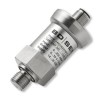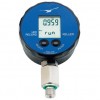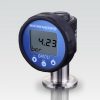Suction pressure is a negative difference in pressure generated between two points which draws a gas or a liquid from a higher to a lower pressure state.
For example if the inlet pressure of a vacuum pump is at 900 mbar absolute and it is connected to a closed chamber at an atmospheric pressure of 1000 mbar absolute, the resulting suction pressure is 100 millibar negative gauge, which will draw down the pressure in the chamber from 1000 to 900 mbar absolute.
 Suction Pressure Sensors - Suction pressure sensors for measuring negative gauge reference pressure. Select pressure sensors for measuring the level of pressure below ambient atmospheric pressure.
Suction Pressure Sensors - Suction pressure sensors for measuring negative gauge reference pressure. Select pressure sensors for measuring the level of pressure below ambient atmospheric pressure. Suction Pressure Transducers - Select suction pressure transducers with a voltage output for measuring suction range pressures.
Suction Pressure Transducers - Select suction pressure transducers with a voltage output for measuring suction range pressures. Vacuum, Suction Pressure Data Loggers, Recorders - Vacuum data loggers for recording negative suction pressure or absolute pressure below atmospheric pressure. Log and store vacuum measurements for printing test reports or analysing process trends.
Vacuum, Suction Pressure Data Loggers, Recorders - Vacuum data loggers for recording negative suction pressure or absolute pressure below atmospheric pressure. Log and store vacuum measurements for printing test reports or analysing process trends. Vacuum, Suction, Negative Pressure Gauges - Vacuum range gauges for measuring absolute vacuum or suction pressures which can be permanently installed or used as a test gauge.
Vacuum, Suction, Negative Pressure Gauges - Vacuum range gauges for measuring absolute vacuum or suction pressures which can be permanently installed or used as a test gauge. Suction Pressure Transmitters - Suction pressure transmitters for transmitting the amount of measured suction pressure. All suction range pressure transmitters measure over a negative pressure range with respect to ambient pressure on the reference side of the sensing diaphragm.
Suction Pressure Transmitters - Suction pressure transmitters for transmitting the amount of measured suction pressure. All suction range pressure transmitters measure over a negative pressure range with respect to ambient pressure on the reference side of the sensing diaphragm.
Questions & Answers
Applying negative pressure to pressure transducer
What happens inside a pressure transducer when negative pressure is applied?
Before negative pressure is applied, there is an equal pressure on the front and rear side of the sensor diaphragm. When the negative pressure is applied, the rear side pressure is now higher than the front side pressure. This causes the sensing diaphragm to flex in the reverse direction resulting in a negative output signal. The negative output signal is often converted to a standardised positive signal such as 4-20mA, 0-10V or 0-5V.
Sensor types for measuring suction pressure
What type of sensing technology is used for measuring suction pressure?
For suction pressures in the range of 0-10 mbar (~0.15 psi) up to
0-1000 mbar (~15psi) it is possible to use strain gauge diaphragm technology. For ranges 0-0.1 mbar up to 0-10 mbar the sensitivity is too small and errors are too great to use a strain gauge diaphragm, so for very low pressures a more sensitive technology such as variable capacitance, inductive or LVDT is used.
Using suction pressure gauge to simulate altitude
Is it possible to use a gauge which reads a vacuum from 0 to -1 bar and convert it to an altitude reading for purposes of simulating altitude testing?
A 0 to -1 bar gauge reference range does not have a fixed reference because the zero reading floats on the atmospheric pressure reading which is constantly changing. In order to set an altitude you need to be able to set the same absolute pressure each time. This would only be possible with a 0 to -1 bar gauge range if you were able to compensate for atmospheric pressure. So it is not going to work unless you are able to continuously compensate for the local atmospheric pressure changes.
Difference between suction pressure & vacuum
What is the difference between suction pressure and vacuum?
Suction pressure is always measured by the amount of pressure below atmospheric pressure e.g. a suction pressure of 100 mbar means 100 mbar below the atmospheric air pressire. Vacuum pressure is similar but should be referred to perfect vacuum e.g. a vacuum of 100 mbar means 100 mbar above a perfect vacuum.
However vacuum is often confused with suction pressure so a pressure described as a vacuum should always be verified to ascertain whether it is referred to atmospheric pressure or a perfect vacuum.
Related Help Guides
- Measuring vacuum as a negative gauge pressure using a dp sensor
- Can you have a minus 20 psi gauge vacuum measurement range
- Measuring vacuum with negative gauge or absolute ranges
- What is the difference between vacuum and absolute pressure
- Can you measure vacuum using a gauge pressure range
- What does negative and positive gauge pressure mean
- Measuring negative pressure using a positive differential pressure range
- Measuring vacuum as an absolute range using a dp sensor
- Output signal orientation for a negative gauge pressure range

